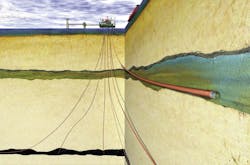Cloud-based Full Waveform Inversion systems provides next stage of earth model building
Nikhil Shah, S-Cube
Understanding the earth’s subsurface is critical to the needs of the exploration and production (E&P) industry for minimizing risk and maximizing recovery. Until recently, the industry’s service sector has not made many advances in data-driven automated earth model building from raw exploration seismic data. But thankfully, that has now changed.
The industry’s leading technique to gain an unprecedented increase in resolution and accuracy when establishing a view of the interior of the earth is known as the Full Waveform Inversion (FWI). Raw seismic data is acquired over a section of the earth and the earth model building consists of numerical simulations through a digital twin of the field experiment itself. A data fitting feedback loop then makes sense of billions of data points from thousands of field experiments at once, matching simulations to the recorded signal.
When it comes to recreating and predicting seismic sensor measurements, FWI is the most powerful machine-driven model-building computational technique. The set of seismic field experiments is simulated using a system of partial differential equations (PDEs) and the iterative updates of the earth 3D rock velocity model result in a detailed view of the subsurface. In fact, FWI creates models that are more accurate and better (10x) resolved than those derived using conventional (tomographic) methods.
Technological advances have now made FWI computationally feasible in 3D and proven with field demonstrations utilizing hydrophone data from ocean bottom and towed streamer seismic surveys. Another breakthrough has proven crucial in enabling a more exact formulation of subsurface imaging. The Adaptive Waveform Inversion (AWI) algorithm formulated by S-Cube in 2015 fundamentally altered how exploration using raw seismic input is tackled.
AWI provides an adaptive way of scoring the seismic measurements predictions using a mathematical mapping between field data and model predicted data. It enables a wider application of FWI which is otherwise reliant on a-priori knowledge of the target, i.e. an accurate starting model. Following through the multivariable calculus, AWI generates more accurate model updates when starting further from true answers.
However, this is not where the evolution of earth model building stopped. The industry has just arrived at the next stage which sees seismic data processing and predictive analytics migrate to the cloud. Earlier this year, S-Cube announced the launch of XWI, its FWI system, on the Amazon Web Services (AWS) cloud computing platform.
The XWI framework consists of a non-linear optimisation toolbox that steers the run to globally minimum convergence to generate the most accurate and detailed earth (velocity) models available using the generic FWI and proprietary AWI cost functions. Additional data-parallel PDE constrained optimization techniques include Reflection Waveform Inversion (RWI) specifically targeting the deepest penetrating energy in the survey, and Constrained Waveform Inversion (CWI) for waveform inversion with geological constraints particularly for salt bodies.
XWI uses reflection, refraction, and turning wave energy in its solution. The inclusion of reflection waves allows the creation of models that penetrate into deeper geology. Using blind-well tests, and in areas with no prior drilling, the framework has demonstrated its predictive power to identify new opportunities at the reservoir level and the XWI products have repeatedly been accurate in identifying reservoirs that future drilling has confirmed.
The key opportunity is to output 3D velocity models several kilometers deep on a dense mesh consisting of millions of pixels, not only for imaging seismic data but to predict rock property measurements within ranges of 70% to 90% along well paths before they are drilled, thus improving well placement accuracy.
The models generated using XWI improve quantitative geological and geophysical workflows, ranging from better seismic imaging to more detailed and accurate reservoir characterization, gross-rock-volume and pore pressure prediction.
Hosted as a pay-as-you-go solution on AWS, XWI is unique to the industry as it combines the most sophisticated waveform inversion techniques with the largest computing facility on the planet. It empowers users with the capability to log and upload an existing seismic project ready to be optimized and upgraded. Users are enabled to systematically test multiple starting models, frequencies, regularization levels, cost functions at once and build extraordinarily accurate 3D models while starting from very basic (often 1D) initial models and only raw field data.
A real-time monitoring dashboard is available for intelligently adjusting settings (and cost functions) to keep steering the run to global minimum convergence and avoiding the danger of getting trapped in a local false minimum from which the model cannot escape. It allows users to quickly compare the results of many experiments, reject bad scenarios, and propose new ones within the same interface. The power of the cloud then reduces simulation time to minutes rather than hours or days.
An additional advantage comes from the platform’s built-in machine learning capability to automatically identify patterns which optimize job performance and parameter keyword settings. The more data and user projects the XWI framework identifies, the more it self-improves.
Tullow Oil as the pilot user has already seen the tangible benefits of XWI on AWS and created value in prospective acreage in the Central Atlantic Margin. The live results were completely user-driven, highlighting the usability and convenience of the framework. Tullow Oil was able to identify an opportunity to increase convergence beyond the baseline score of 59% to 75% with higher convergence rates continually being achieved.
Using this framework, the energy company is able to robustly deploy seismic data processing on the cloud in the highly agile and interactive manner needed for superior quality results that give E&P competitive advantage. •
